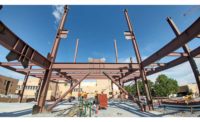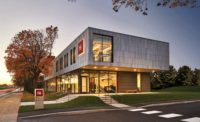"What Sept. 11 has done is accelerate development and deployment for projects with security applications," says Duane Lindner, deputy director of chemical and biological programs for Sandia National Laboratories, Sandia, N.M. Because the attacks broadened the list of possible threats to Americans, Sandia Lab is pushing security projects from the development stage to actual use more rapidly, Lindner says.
 |
| HANDHELD LAB Tool yields quick air analysis onsite. (Photo courtesy of Sandia National Laboratories) |
QUICK READOUTS
One of Sandia's fast-track projects is the MicroChemLab, a handheld device that analyzes the surrounding air for nerve and blister agents, along with biotoxins, in about three minutes. Traditional monitors are as big as a copy machine and can only be operated by a trained person. The MicroChemLab is made to be easily used by a civilian or a firefighter. The device has been in development since 1997, but the heightened fear of biological attack has sped up the testing and lab processes over the past year.
Biological weapons are "easy for unsophisticated countries to get their hands on," so it is important not to discount the harm they could cause, Lindner says. For example, the deadly nerve toxin ricin can be fairly easily extracted from castor beans, and directions to make it were available on the Internet until a year ago.
The handheld lab takes the mixture of chemicals in the air and separates them by forcing them through the device, using either gas or liquid. Different chemicals leave chemical "signatures" with varying retention times.
Sandia currently is using the mini-lab at an undisclosed international airport in the U.S., where an analysis of air is performed every few minutes. According to Lindner, MicroChemLab will sell for about $5,000 within two years.
 |
| PORTABLE New monitors are designed for use in the field. (Photo courtesy of Pacific Northwest National Laboratory) |
BOOST FOR SECURITY DESIGNERS
Not only did the terrorist attacks speed up development of security technology, but they also created more business for designers, contractors and manufacturers specializing in security. Since Sept. 11, 2001, revenue is up 15% at Enclos Corp., Bloomington, Minn., which designs blast-resistant curtain walls for courthouses, says John Walker, vice president of design. Courthouses and other federal buildings were being hardened against blasts prior to the 9/11 attacks, but other locations like airport terminals and smaller federal buildings now are using blast-resistant engineering as well, he says.
In July, Enclos successfully tested a curtain wall design for the Bronx Criminal Court Complex at a large blast thermal simulator at the White Sands Missile Range in New Mexico. With New York City-based consulting engineers Wiedlinger Associates, Enclos constructed a 600-sq-ft mock-up of the courthouse wall, and then strung explosives to create a uniform pressure.
"We take a standard curtain wall and design it to the architects' needs, and then we design for wind and water needs, and lastly for blast loads," Walker explains. The courthouse wall was particularly designed to withstand a pipe bomb or briefcase-sized bomb placed a few feet from the wall, most likely by a suicide bomber, he says.
The General Services Administration sets requirements for blast resistance based on an anticipated event, and evaluates the resistance during testing by how many sections of laminated glass break in the mock-up. According to Walker, the intent of the curtain wall is to absorb the blast, transferring the load to different areas of the structure.
"The most difficult thing about these designs is realizing we can't protect people against a 5,000-lb truck bomb," Walker says. Although the curtain wall does not guarantee safety for all blast loads, many cities have been willing to pay a premium for a blast-resistant curtain wall. The Bronx Courthouse's protective exterior shell cost $36 million, while a standard curtain wall would have cost roughly $31 million, Walker says.
Enclos currently is working on courthouse designs in Seattle and Fresno, Calif.
 |
| SMALL AND LARGE Biofilter developed at Auburn is designed for gas masks or HVAC systems. (Photo courtesy of Intramicon) |
SMALL FIRMS RAMP UP
Larger corporations are not the only ones accelerating their security technology projects. IntraMicron, Inc., a small firm based in Birmingham, Ala., got its start from Auburn University lab work. Principal Bruce Tatarchuk, a chemical engineering professor, created renewable filters that have interchangeable components to protect against a biological weapons attack.
Another, Birmingham firm, engineer-contractor BE&K, teamed with IntraMicron to develop a filter that can be used in HVAC units for buildings, or in individual gas masks. The microfibrous technology can filter out particles ranging from sarin and anthrax to pollen and dust mites. Financed with over $15 million of federal money since 1992, Tatarchuk has worked to create a filter that can address a "cocktail" threat, made up of a combination of chemical agents.
"When I talked to people the summer before Sept. 11 about this filter and gas masks, they looked at me funny," says John Stein, CEO of IntraMicron. "But the need on Sept. 10 and Sept. 12 wasn't all that different. The government knew this was a problem for a long time, and the public perception has caught up with the government's perception."
The filter is made by placing sorbents in a mesh of nickel metal fibers 3 microns in diameter and cellulose wood fibers, that under a microscope resembles a wad of chicken wire, says C.H. "Stretch" Dunn, director of federal programs for BE&K.
The mix of sorbents is tailored to the anticipated threat. The fibers are put through a paper machine on a roll, and then the sheets are sent through a furnace at 1000� C, melting the cellulose fibers and fusing the metal fibers together. The resulting sheets are then cut into strips and placed in canisters for either building units or gas masks. The filter sheets can be fully renewed simply by being reheated, any number of times. The price of equipping one HVAC unit is about $250,000.
The terrorist attacks initiated a heightened commercial interest in the filters that moved the development process along more quickly, and also intensified the sense of commitment among the development team, Tatarchuk says. "After Sept. 11, I got angry and very much more intense and determined to see a better, safer and more economical solution get placed on the market," says Tatarchuk. "I want to see a broader level of protection across the U.S. It's not a question of if these filters will be useful, but when." The collective protection filter unit now is being tested by the government in military barracks in Anniston, Ala.
Other security technology programs that were under testing prior to Sept. 11 have been expanded to other areas, because of more support from the federal government. Sandia National Laboratories set up an air-sensor system in a Washington, D.C., subway station two years ago that detects nerve or blister agents. After a large false alarm rate due to temperature swings, among other things, Sandia's researchers went back to the drawing board and now say they have created a system that is more reliable. Engineers map the airflow of the station, with the trains acting as a pump, and then place sensors accordingly.
Congress increased its support for the sensor work after Sept. 11, and has requested Sandia to expand the program to more stations. The system will be working in multiple Washington stations by the end of the year, and one station in Boston during 2003. Installation costs are about $1 million per station.
 |
| BLAST-OFF Angled curtain wall design dissipates forces from explosion. (Photo courtesy of Enclos Corp.) |
SAFEGUARDING WATER
Another sensor system has been under development for two years at Oak Ridge National Laboratory in Tennessee. The Large-Scale Drinking Water Sentinel screens the safety of municipal water supplies by monitoring the levels of naturally occurring algae in the water. The system provides real-time information on the presence of biological or chemical hazards such as cyanide in water, while most lab tests of water require several hours for results at best, according to Michael Kuliasha, director of Oak Ridge's computational physics and engineering division.
While security technology programs are expanding and security engineering companies are receiving more business because of the increased fears of terrorism on American soil, the people who have worked in the industry for decades say that the need for these technologies is not exactly a new development. "The reality is that these issues aren't a fad," says IntraMicron's John Stein. "The issues of protection, whether we like it or not, are here to stay for the U.S."
On the other hand, the certainty of support from government and commercial agencies is not yet a sure thing for security design firms.
"There's so much concern and activity" surrounding the security field, says IntraMicron's Tatarchuk. "I don't know right now how homeland [security] monies will filter down to the technical level, or how long the commercial interest will be there. I can only hope to continue to provide solutions."
efore the terrorist attacks of Sept. 11, engineering and development work on security devices often bogged down in the testing and commercialization process. The journey from concept to market could span 20 years or more. The attacks stimulated a sense of immediacy.

